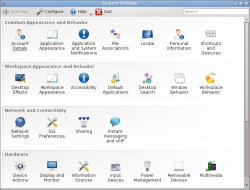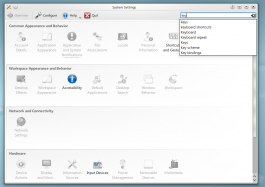System Settings/zh-cn: Difference between revisions
Updating to match new version of source page |
Updating to match new version of source page |
||
| Line 153: | Line 153: | ||
==鼠标手势 == | ==鼠标手势 == | ||
{{Note|3=Note for translators|1=This section has been moved to [[/Shortcuts and Gestures]]. We shall leave the content here as well for some time to make it easier to move your translations.}} | {{Note|3=Note for translators|1=This section has been moved to [[System Settings/Shortcuts and Gestures]]. We shall leave the content here as well for some time to make it easier to move your translations.}} | ||
:''KDE SC 版本 4.4.4'' | :''KDE SC 版本 4.4.4'' | ||
Revision as of 14:23, 8 August 2011
特性
- KDE 平台全局配置中心
- 方便地自定义和管理你的桌面
- 搜索功能帮您缩小可能的设置
搜索
系统设置有个搜索功能帮您找找某个设置模块。只需在工具栏的搜索框中输入,系统设置就会显示包含关键词的设置模块,并隐藏无关模块。您还可通过 KRunner 运行系统设置模块。
分类
公共外观和行为
账户细节

配置你的用户信息、密码和路径。你还可以配置社会化桌面提供方。 应用程序外观

配置应用程序风格、颜色、图标、字体和表情符号。 Application and System Notifications

Configure the notifications you want to receive from the system, and from applications File Associations

Set default actions and icons for different types of files. Locale

Language, numeric, and time setting for your particular region. Allows you to apply translation (locale) to whole KDE Desktop or change spellchecker parameters. Personal Information

Configure the resources used to manage your address book, calendar, and notes Shortcuts and Gestures

Configure keyboard shortcuts and mouse gestures.
Workspace Appearance and Behaviour
Desktop Effects

Configure desktop effects such as window animations, transparency, or the desktop cube. Workspace Appearance

Configure the appearance of windows, cursors, and the desktop. Accessibility

Settings to help users who have difficulty hearing audible cues, or who have difficulty using a keyboard. Default Applications

Set the default applications for common tasks, such as browsing the web, writing email, or managing files. Search Desktop

Settings for the desktop search engine. Window Behaviour

Configure task switching, and how windows respond to mouse actions. Workspace Behaviour

Settings for overall workspace behaviour and virtual desktops.
Network and Connectivity
Bluetooth

Set up connections to your Bluetooth devices. Network Settings

Preferences for your network connections and proxy settings. SSL Preferences

Manage SSL certificates. Sharing

Settings for sharing files with Windows machines over a network.
硬件
Device Actions

Configure which actions are available when a new device is connected to your machine. Digital Camera

Settings for connecting to your digital cameras. Display and Monitor

Configuration of your monitor(s) and screensaver settings. Information Sources

Configuration of hardware for network, remote control, and modems. 输入设备

配置键盘、鼠标和手柄。 Power Management

Global settings for the power manager. Removable Devices

Configure automatic handling of removable storage media. Multimedia

Configure the handling of audio CDs
系统管理
Actions Policy

Configure policies for trusted actions in the system. Date & Time

Settings for date and time. Font Installer

Install, manage, and preview fonts. Global Policy Configurations

Configure global settings for system policies. 登录屏幕

配置登录管理器(KDM). Permissions

Software Management

Get and remove software, and manage automatic updating of software. 开关机

配置系统开关机时的行为。
鼠标手势
- KDE SC 版本 4.4.4
打开 ""
启用鼠标手势
窗口底部左侧有个按钮。确定复选框已经打钩。设定好你认为合适的超时时间。鼠标按键可能你那边会不一样,我是用 3 来设定使用鼠标右键。如果你希望输入动作自动启用,勾选上面的"登陆时自动启动输入动作守护进程"。
创建鼠标手势动作组
右击左窗格(动作组列表的底部空白区域),选择,然后重命名组为"鼠标手势",并勾选组名后的复选框。
新建鼠标手势
从现在起,我假定新的组是叫作"鼠标手势"。右击,选择(这里有三个选项,但我没打算用"发送键盘输入"),使用"命令/URL" 或 "D-Bus 命令",你需要创建一个手势绑定到动作上。
新建手势
点击,选择 标签。界面底部有个按钮(点它)。在打开的框里用鼠标左键绘制手势。
绑定动作
如果你选择 ,只需要在标签的区域输入命令或url便可。
命令/URL 示例
关闭窗口
此命令可以让你关闭鼠标点击的窗口。
Command/URL: wmctrl -c :SELECT:
关闭当前活动窗口
Command/URL: wmctrl -c :ACTIVE:
翻译剪贴板内容
此命令会显示当前剪贴板内容的翻译。
- 需要组件:
- xclip
- libtranslate
Command/URL: kdialog --title "Translation" --msgbox "`xclip -o | translate -f en -t he -`"
替换 'en' 和 'he' 成源语言和目标语言,要是你不确定,the ISO 639-2 有完整的语言代码名单。
D-Bus 用法示例
如果你选择了D - Bus,这里有几个例子。
要填些什么内容,得求助于"Launch D-Bus Browser",用那个浏览器可以找到程序对象需要调用的方法。我们需要填写属性字段(fields)来使用 D-Bus,字段(field)名样式常规,而内容样式是斜体。
Runner
显示 Runner 对话框。
远程应用程序:org.kde.krunner
远程对象: /App
函数:org.kde.krunner.App.display
Audacious next/previous/pause/play/stop/repeat 音轨
远程应用程序: org.mpris.audacious
远程对象: /Player
函数: org.freedesktop.MediaPlayer.Next (把 Next 替换成 Prev/Pause/Stop/Play/Repeat)
Audacious 播放/暂停音轨
若当前没播放则开始播放,若当前播放则暂停中止。
远程应用程序:org.mpris.audacious
远程对象: /org/atheme/audacious
函数: org.atheme.audacious.PlayPause
Klipper 手动调出动作菜单
显示动作弹出 (我用那个来搜索和翻译词组)
远程应用程序: org.kde.klipper
远程对象: /klipper
函数: org.kde.klipper.klipper.showKlipperManuallyInvokeActionMenu



